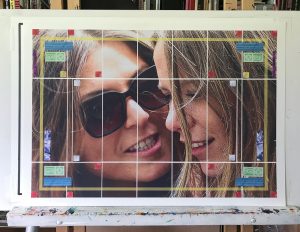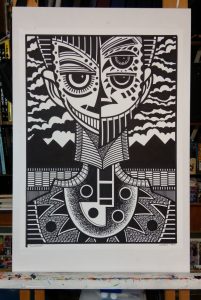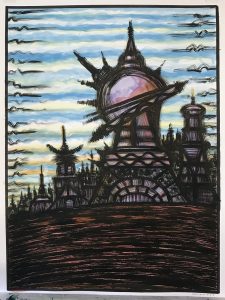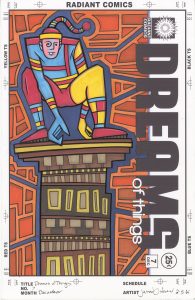I recently made seventeen ASMR live marker drawing videos. That may mean nothing to anyone else but to me it was completing a pretty amazing task. Each video is of me spontaneously drawing with a marker on a five by seven inch piece of paper. No underdrawing in pencil. I grab a marker, start drawing, and don’t stop until I have filled the paper. There is no talking by me either. All you hear is the sound of the marker on the paper. Each video takes between fifteen and twenty minutes to do and though they might look easy they take a lot of concentration.
I’ve made and posted (on YouTube) a bunch of these type drawings before but I haven’t made any in a while. According to the dates on the digital files I haven’t make one in about eight months and only made a half a dozen of them all of last year (2018). So you can see why getting seventeen of them done in a row is an accomplishment to me.
I have done a bunch of similar ASMR live drawing videos of my cartoon art cards but they’re not the same. I draw the cartoon art cards for my Sunday “Drifting and Dreaming” strip so I decided to film myself drawing them. They’re smaller drawings at only 2.5×3.5 inches and they’re all drawings of a single face each. Before I turn the camera on I draw a border and word balloon on each card and then write the card. Whatever writing I come up with gets written in pencil in the word balloon.
It’s at this point I turn the camera on. I have the camera on a small tripod that sits on my drawing table. It sits between my face and the paper so that makes it kind of hard to see the paper. I have to look around the camera in order to draw but I also have to keep my eye on the camera’s screen to make sure the drawing is framed properly. I can sometimes move the drawing off screen as I draw so I have to be sure to move it back.
As I said before these cartoon art cards aren’t as hard to do as the spontaneous marker drawings. First I throw down some pencil lines to outline a face. Then I go into the detail of the faces with a black marker. After that I letter over the pencil lettering with a black marker to finish the lettering. Before I grab my color markers and fill in all the color on the piece I erase any stray pencil marks in the drawing. I don’t erase the penciled lettering underneath the ink lettering until the very end. The inked lettering has to dry completely or it will smear. This takes a few minutes.
Each one of these cartoon art cards takes about ten minutes of on screen time to do. That doesn’t count the writing time but that’s not too bad overall. As videos they’re all kind of the same though. You know what you are going to get. The face of a strange character saying something strange to you. I started filming these cards on a whim. I figured why not? I was making them anyway so I might as well film them since it was fairly easy to. All I needed was some quiet.
The spontaneous marker drawings are a different story. They take a lot of concentration. I’m starting with nothing and have no idea what I’m going to draw. I have to clear my mind of its preconceived notions and respond to the marks I’m making on the paper. At different points in the drawing I have to make conscious choice about what I’m doing but at other points I have to react without thinking. It’s a process called “Surrealist Automatic Drawing” that helps create dream like images.
Each drawing may only take fifteen to twenty minutes to make but it usually takes me just as much time between drawings to recover and get ready for the next one. I started drawing the first for the seventeen drawings one night and it was on a whim. I hadn’t gotten anything creative done all day and was looking for something to do. Since I had a few days alone in the house I decided to take advantage of the quiet and get some done. I usually don’t start anything at night but I got these three drawings done from about seven to nine PM. A pretty good start.
The next day I had a lot of interruptions. I had my usual bike ride in the morning, a trip to the store with a friend, and my weekly trip to the comic shop to pick up my pull list. That’s more errands than I usually have in one day but I still managed to get seven ASMR drawing videos made. It’s not always easy to get anything creative done when I’m interrupted more than once but somehow I got stuff done. I was pretty happy about my ten videos and drawings.
The next morning I decided to do some more of these drawings. I had until about 2PM until my family arrived home so I decided to take advantage of the quiet to film some more. I also had no interruptions that morning. From about 8AM until somewhere around 2PM I managed to get seven more videos made for a total of seventeen. That’s a pretty impressive number. I really wasn’t expecting to get another seven done that last day so I surprised even myself.
I made the drawings mostly with Sharpie markers. I used various colors because that made things more interesting for me as I drew. I made two of the drawings with a Copic marker and one of them was drawn in pencil. I was happy that I had a lot of five by seven inch pieces of paper already cut up from when I was cleaning up the place a while ago. I cut up larger pieces of 11×17 inch paper that I messed up the front of so I can make smaller drawings on the back.
It also takes a bit of work after making the drawings and shooting the video. First I have to name all the drawings and write the name on the back of them so I can distinguish one from the other. Then I have to scan all the drawings in and name the files. Plus I have to transfer all the video to my computer and name all those files too. Finally I have to make a thumbnail of the drawing to post on YouTube for when I upload the video. It’s all the organizational stuff that nobody ever thinks about but has to be done.
I’ll be posting these videos over on my YouTube channel over the coming months. Probably one a week. Keep and eye out for them.




